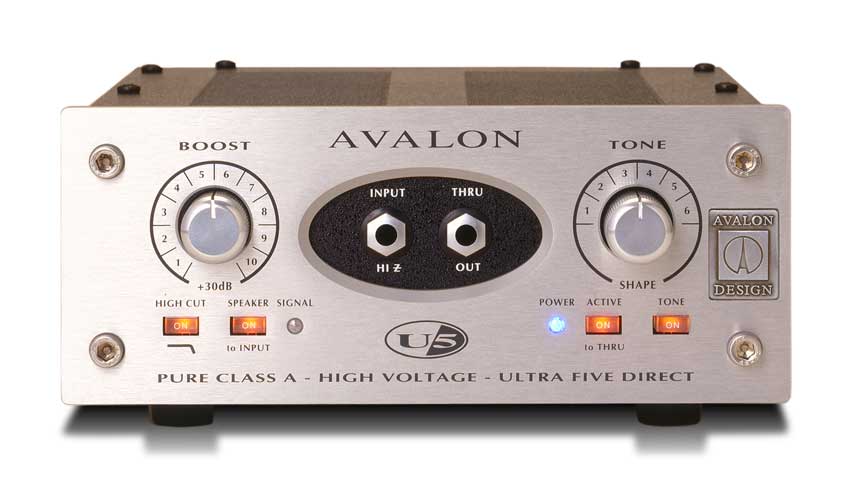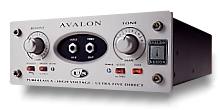
| REVIEWS: |
|||
|
Terry Buddingh for Bass Player Magazine
AVALON DESIGN U5
ULTRA FIVE DIRECT BOX INSTRUMENT PREAMPLIFIER
Avalon Design has been building high-quality EQs, compressors, and preamps for more than 15 years. The company's U5 DI/preamp - a favorite of many respected studio bassists - has earned a reputation for great low frequency response and clarity. Construction The U5 is built to withstand everyday studio use. An attractive 1/4" brushed-aluminum faceplate adorns the front of its heavy steel chassis. Stainless-steel allen bolts secure the front panel and the double-sided glass-epoxy PC board to the chassis. Stainless-steel hardware is significantly more expensive than conventional steel fasteners, but Avalon's preference for stainless indicates the company's concern for quality and attention to detail. The hefty BOOST and TONE knobs are machined from solid aluminum, and orange LEDs back-light the clear plastic switch buttons. A DI's jacks can be subjected to lots of stress, especially in a pro studio. Avalon uses flying leads to connect the jacks to the PC board, which isolates the board and its components from mechanical shock. Flying leads require labor-intensive hand soldering. (Manufacturers often use less-rugged board-mounted jacks to cut manufacturing costs.) A small PC board containing nine resistors is attached directly to the ten-position BOOST switch. Another small PC board is attached to the six-position TONE switch. The board holds all the resistors and capacitors that comprise the U5's passive EQ circuitry, which includes many hi-fi-grade polystyrene and polycarbonate capacitors. Avalon shields the toroidal power transformer to reduce hum-inducing magnetic fields.
Avalon prefers to use discrete components rather than op-amp ICs. Budget minded manufacturers prefer ICs because they pack many components into a tiny low-cost package. Discrete components perform better, though, and they allow you to test and select individual components based on specific sonic characteristics. Avalon also prefers DC coupling of its preamp stages, which might be considered a purist design technique. It may be the path to deeper bass and purer sound, but DC-coupled circuits can be prone to producing pops and snaps when you plug in or change control settings. Ease of Use The U5 is very versatile: You can use it as a classic DI box, with the MIC LEVEL output feeding a mixer and with the THRU OUT routed to your amp; or you can use the LINE LEVEL output to record direct to tape. You can even plug a head's output directly into the U5's SPEAKER IN 1/4" jack (400 watts max). You can also use the LINE LEVEL OUTPUT to drive a power amp for live playing. The ten-position BOOST switch makes it easy to adjust the output level and accurately replicate previous settings, and the six-position TONE switch provides useful tone-shaping options. Hear a little too much highs and string noise? Just hit the well-voiced HIGH CUT button. Avalon even included a stereo headphone jack so you can monitor yourself while recording without having to route through the studio's console. This also makes the U5 a killer headphone practice amp! In spite of all its options, the Avalon is very intuitive in its operation. Sound We tested the U5 in a live rig with a Hafler Pro5000 power amp and Acme Low B-2 cab, as well as with a Stewart World 2.1 power amp driving an Eden D-410XLT. We also recorded direct to a Panasonic SV-3800 DAT deck, monitoring with a pair of Sennheiser HD600 headphones. Our test basses (which ranged from a '64 Fender Jazz to a Lakland 5-string) sounded remarkably smooth and refined through the U5, with effortless dynamics and a rich yet balanced sound. Our Lakland 5-string's lowest notes sounded clear, with lots of stringy detail and great focus. It's amazing how well the Avalon responds to subtle dynamics and nuances. Our Sennheiser HD-600 headphones revealed microscopic sonic details - this combination could be unsurpassable for evaluating instruments. We preferred TONE positions 1 and 3 for fingerstyle playing and position 2 for slapping. Position 4 sounded the flattest of the EQ curves, and the rolled-off bass positions 5 and 6 might be useful in especially boomy live situations, or when you need to really cut through a recording. In short, all the TONE position sounded useful given the right circumstances. We did notice a little signal loading (roll-off of highs resulting from poor impedance matching) with our Underwood piezo-equipped German upright, which performs better with DI's that have impedances of 4 megOhms or more. The U5's 3 megOhm input impedance is more than sufficient for active and passive electric basses, though--although a higher input impedance could increase noise levels. We also noticed some popping when switching between the highest boost settings. And when plugging or unplugging our basses, probably a side-effect of the DC coupling. We learned to turn the BOOST switch all the way down when changing basses. We'd rather deal with the pops than sacrifice any of the U5's glorious tone for the sake of convenience. Value If you're thinking $595 is a lot to pay for a DI, consider the U5 can also be used as a preamp and headphone amp. And if you have a home studio, it can impart big-league polish to your recordings. Once you become accustomed to the U5's high-resolution detail, you may wonder how you ever lived without it.
Technical Specifications Type: Solid-state, Class A, AC powered DI/PreampMade in: USA List Price: $595 AC Power: 150 Volts or 230 Volts selectable Noise: -100dB @ 20kHz (unweighted, no BOOST) Distortion THD, IMD: 0.1% @ +10dB Frequency Response: 5Hz-100kHz Warranty: 1-year limited Dimensions: 3 1/2" x 8 1/2" x 12" Weight: 7 lbs. Options: RM-1 Rackmount Kit ($80)
Back to Reviews Index & User List |
|||
Tel: +1 949 492 2000
©2023 Avalon Design USA LLC

